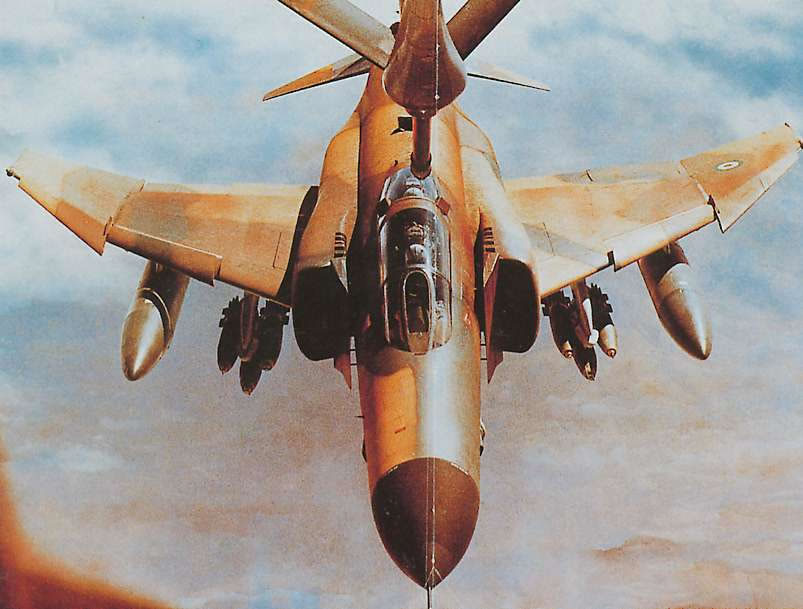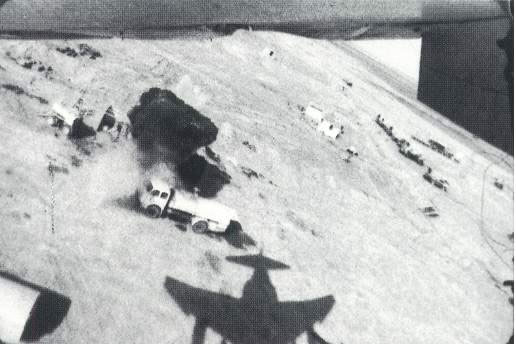|
Posted on 06/19/2005 10:35:04 PM PDT by SAMWolf
|
|
 are acknowledged, affirmed and commemorated.
|

| Our Mission: The FReeper Foxhole is dedicated to Veterans of our Nation's military forces and to others who are affected in their relationships with Veterans. In the FReeper Foxhole, Veterans or their family members should feel free to address their specific circumstances or whatever issues concern them in an atmosphere of peace, understanding, brotherhood and support. The FReeper Foxhole hopes to share with it's readers an open forum where we can learn about and discuss military history, military news and other topics of concern or interest to our readers be they Veteran's, Current Duty or anyone interested in what we have to offer. If the Foxhole makes someone appreciate, even a little, what others have sacrificed for us, then it has accomplished one of it's missions. We hope the Foxhole in some small way helps us to remember and honor those who came before us.
|
|
The F-4 Phantom The F-4 Phantom brought a new level of air warfare to the Middle East in 1969.  To Israel, it was a technical marvel. To the Shah of Iran, it was the means to dominate the Persian Gulf. When the McDonnell F-4 Phantom reached Tel Aviv in 1969, it marked a dramatic shift--the first time the Israeli state, not a formal ally, received advanced military hardware from the United States. When the Phantom reached Iran a year later, it was still a class act, like the Persian nation's famous caviar. To the two Middle East nations, not far apart yet utterly different, the F-4 Phantom was the biggest, fastest, most powerful and expensive fighter ever built. It was, very simply, the standard against which every other fighter through the end of the century would be measured. Not that the F-4 Phantom looked like much. It looked, in fact, like someone had stepped on the blueprints. It had bent wings, a sharply downswept horizontal tail slab, and a pointed nose with an abruptly fattened aft fuselage holding two powerful General Electric J79 engines. Those turbojet engines produced 17,000 pounds of thrust (8,120 kilograms) with afterburning.  To be used by men in a line of work usually viewed as a solo performance fighter pilot-the Phantom had two seats for two crew members. Over North Vietnam, Americans had learned that having two men aboard provided an extra set of eyes and ears, a second opinion, a second chance to see the bad guys first-although by 1969 two pilots were replaced by a pilot/radar operator team. And the two engines meant redundancy and greater prospects for survival when hit by gunfire. In close encounters with MiGs over Hanoi, Americans learned the most bitter lesson of all. The Phantom had been designed without a gun because the Pentagon thought the age of the missile had arrived. This was a catastrophic mistake-so a 20mm M61A1 Vulcan "GatIing" gun was belatedly slung under the nose of the F-4E model. The modification looked distinctly like an afterthought, its barrel poking out from nose contours that weren't particularly streamlined anyway. Other lessons: the Phantom carried four Sparrow radar-guided missiles in recessed bays under the fuselage, and could use them in a head-on engagement beyond visual range--a capability North Vietnamese MiGs lacked-but in 'Nam the rules said you had to see before you could shoot. The Sparrow was good up to 15 miles or so even when this advantage was not seized; the radar-guided, AIM-4D Falcon missile (introduced with the Phantom F-4D) was useless, and fighter ace Colonel Robin Olds forebade his men to use them.  At closer range, the Phantom's infrared heat-seeking missiles, the Sidewinders, were unmatched; this was becoming the most important air-to-air missile of the era. Following the Six Day War of 1967, the Israeli Defense Force/Air Force (IDF/AF), or Tsvah Haganah Le Israel/Heyl Ha'Avir, needed a front-line fighter. In January 1968, the United States completed delivery of 48 aging A- 4 Skyhawks promised before the war, and President Johnson offered Premier Eshkol 20 more. But pressure built to supply Jerusalem with a newer fighter. Although Johnson was opposed, he began negotiations on October 9, 1968, after presidential candidate Richard M. Nixon came out in favor of it. On December 27, 1968, after Nixon's election but before he took office, the announcement was made of the sale of 50 Phantoms to Israel to be delivered beginning in 1969 at a cost of $200 million. The Phantoms began to arrive in September 1969 and were committed to battle on January 7, 1970. The first mission was led by squadron leader Samuel l Chetz, already an ace, against Soviet-constructed SAM (surface-to-air missile) and radar installations at Dahashur. Chetz, known for his aggressive spirit, was later killed in a low-level strike on a SAM site, a loss which permitted Jerusalem to reveal his name although the identities of active pilots remained undisclosed.  The war of attrition was coalescing as a struggle in which air power could help Israel compensate for its inferiority in artillery along the Suez Canal. To redress the "artillery gap," Skyhawks and Phantoms silenced Egyptian missile, antiaircraft and artillery batteries. To a nation under siege, fiercely proud of its plucky and undaunted air arm, the arrival of the $4 million F-4E Phantom was timely. In the hands of aggressive and spirited Israeli crews, the Phantom shook Egyptian leaders who watched their air defense network being systematically picked apart in low-level strikes. Other F-4Es ranged against targets deep inside Egypt. On July 30, 1970, Soviet pilots helping the Egyptians tangled with Israeli Phantoms in a raging dogfight over the Gulf of Suez. It was the first test of the E model Phantom's cannon in combat. The Israelis shot down five MiG-21s. Soon thereafter, on a marathon 2,000-mile strike mission to Ras Banas, Phantoms bombed and sank a Komar-class missile boat and a 2,500-ton Z-class destroyer.  A more controversial incident occurred in February 1973. Israeli Phantoms intercepted a Libyan Boeing 727 airliner when it penetrated the Israeli-occupied Sinai Desert on a heading which suggested an intelligence-gathering mission. "We tried desperately to force it down, not shoot it down," said Maj. Gen. Mordechai Hod, IDF/AF chief. Two Phantom pilots exchanged hand signals with the Libyan pilot but were unable to persuade him to follow them to Bir Gifgafa Air Base. A Phantom fired a warning burst of 20mm. The airliner lowered its wheels but raised them again and banked in an apparent attempt to escape. The Phantoms shot it down. One hundred five of the 112 people aboard died. Even after Anwar Sadat booted out his Russian advisers on July 18, 1972, tension persisted. Many in Israel feared that a new conflict was near. At least, it seemed, the situation was stable in the Persian Gulf where Iran, prospering from skyrocketing oil prices, was arming itself to the teeth. The Shah said openly that he wanted to be the decisive force in his region
|
The way you describe it, it sure sounds like it. Some memories are just so much better tham others. :-)
Do not eat at Jose's Tacos before flight.
ROTFL!!
:-)
Wow, that was a whirlwind trip! You've done a great job bringing us the battlefields, thanks so much. Funny that Sam and I were just over some of those same grounds in January and the November before that. Neat.
LOL!
Slacker! :-)
That's true. All my threads require less work. LOL. I'm determined to get Sam to do shorter threads so it frees up some of his time but so far he won't budge. Stubborn.
The store is going good but even on slow days we still have to be cooks and bottlewashers, so to speak. :-)
LOL. Thanks Phil.
Wow. Neat story, thanks for sharing. What a rush that must have been!
BTTT!!!!!!!
LOL. Don't hold your breath yet, but triple is coming soon.
In the following decade we did a lot of Pellas which offered an insulating glass pane plus removable dual glazing panel (DGP) totalling three panes.
The current Pella product line shows this example:

I have their CD but their drawings are accessible from this page: How To Download Drawing Files
What do you do for a living Phil?


Disclaimer: Opinions posted on Free Republic are those of the individual posters and do not necessarily represent the opinion of Free Republic or its management. All materials posted herein are protected by copyright law and the exemption for fair use of copyrighted works.